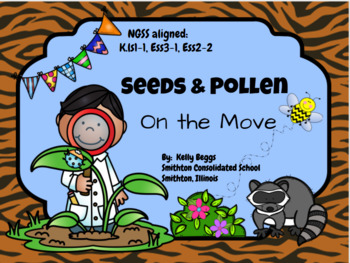Seeds and Pollen On The Move (A NGSS Aligned K.LS.1-1, ESS3-1, ESS2-2)
Kelly Beggs
21 Followers
Grade Levels
PreK - 2nd
Subjects
Resource Type
Standards
CCSSK.MD.B.3
CCSS1.MD.C.4
CCSS2.MD.A.1
Formats Included
- PDF
Pages
30 pages
Kelly Beggs
21 Followers
Description
This Unit on Seeds and Pollen is filled with hands-on engaging lessons and science experiments all aligned with the NGSS K.LS.1-1, ESS3-1, & ESS2-2. It also includes common core math standards as well. This unit includes
* Pre/Post Test & answer key
* The Pollination Experiment using Cheetos (how bees move pollen)
* The Sock Walk Experiment (how animals transfer seeds)
* Up, Up and Away Experiment (how wind moves seeds)
* Sink or Float Seeds Experiment (how water moves seeds)
All experiments have ready-made printables to begin your lessons immediately.
Students will gain a total understanding of HOW ANIMALS CHANGE THE ENVIRONMENT when they are finished with this unit.
Students will want to do the experiments again and again.
Great for whole group instruction or Science Centers.
This is definitely a great STEAM (Science, Technology, Engineering, Art & Math) Unit.
Use technology by filming experiments and uploading it to your blog or Seesaw account for parents to see.
Build a model of a pretend animal that can carry seeds.
* Pre/Post Test & answer key
* The Pollination Experiment using Cheetos (how bees move pollen)
* The Sock Walk Experiment (how animals transfer seeds)
* Up, Up and Away Experiment (how wind moves seeds)
* Sink or Float Seeds Experiment (how water moves seeds)
All experiments have ready-made printables to begin your lessons immediately.
Students will gain a total understanding of HOW ANIMALS CHANGE THE ENVIRONMENT when they are finished with this unit.
Students will want to do the experiments again and again.
Great for whole group instruction or Science Centers.
This is definitely a great STEAM (Science, Technology, Engineering, Art & Math) Unit.
Use technology by filming experiments and uploading it to your blog or Seesaw account for parents to see.
Build a model of a pretend animal that can carry seeds.
Total Pages
30 pages
Answer Key
Included
Teaching Duration
30 minutes
Report this resource to TPT
Reported resources will be reviewed by our team. Report this resource to let us know if this resource violates TPT’s content guidelines.
Standards
to see state-specific standards (only available in the US).
CCSSK.MD.B.3
Classify objects into given categories; count the numbers of objects in each category and sort the categories by count.
CCSS1.MD.C.4
Organize, represent, and interpret data with up to three categories; ask and answer questions about the total number of data points, how many in each category, and how many more or less are in one category than in another.
CCSS2.MD.A.1
Measure the length of an object by selecting and using appropriate tools such as rulers, yardsticks, meter sticks, and measuring tapes.





